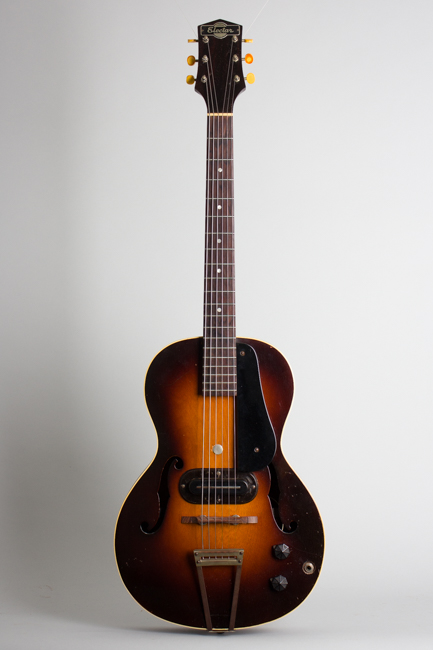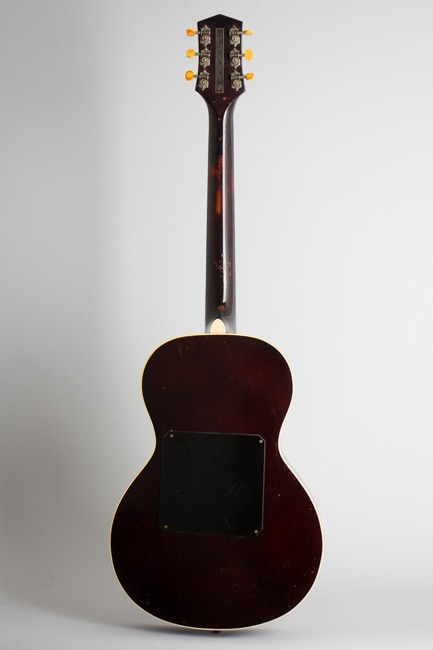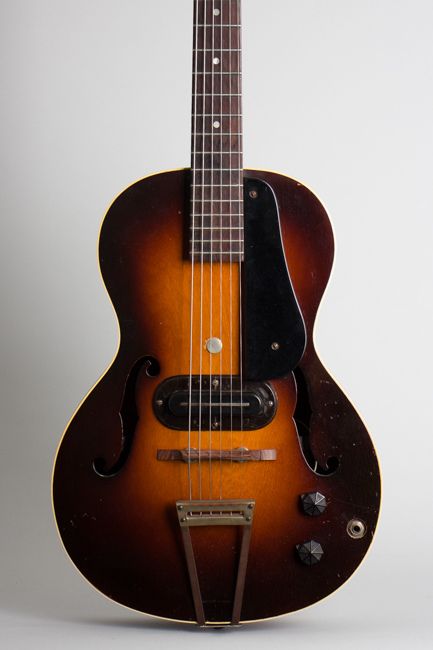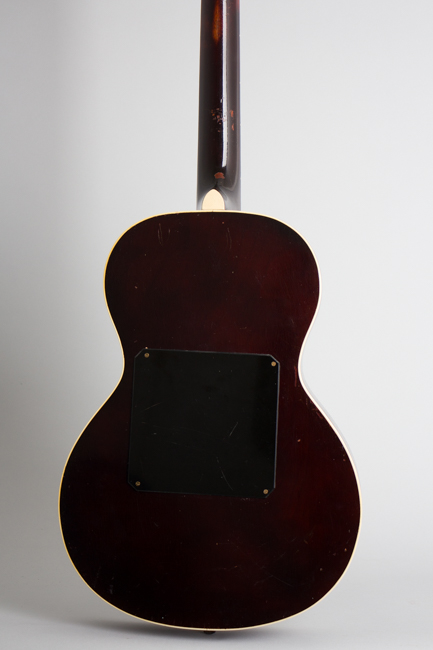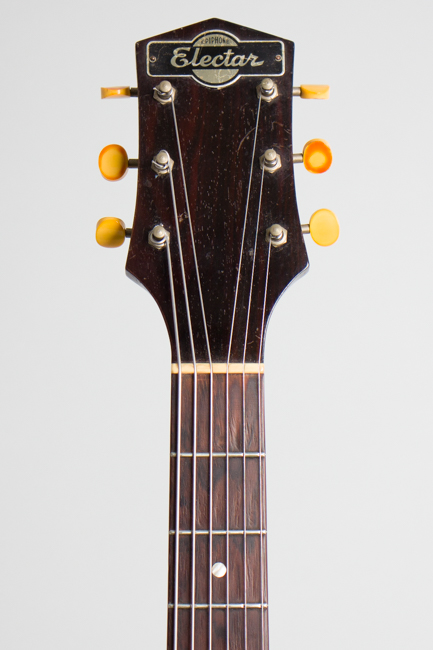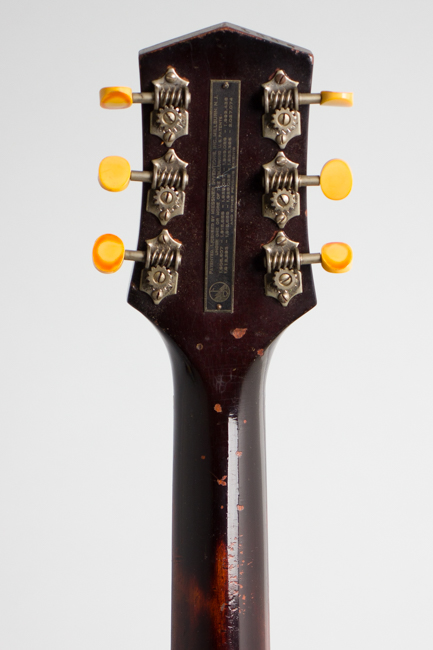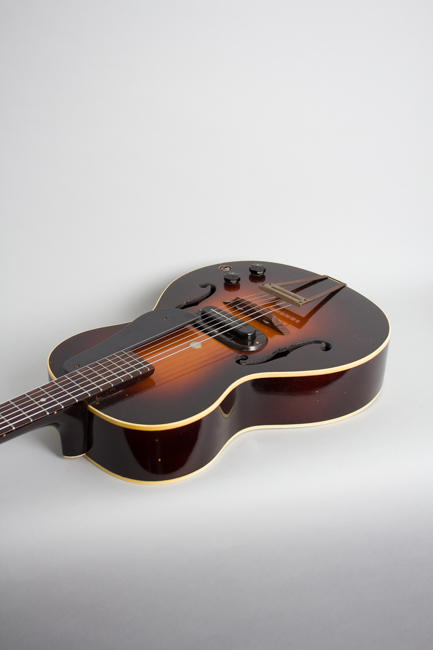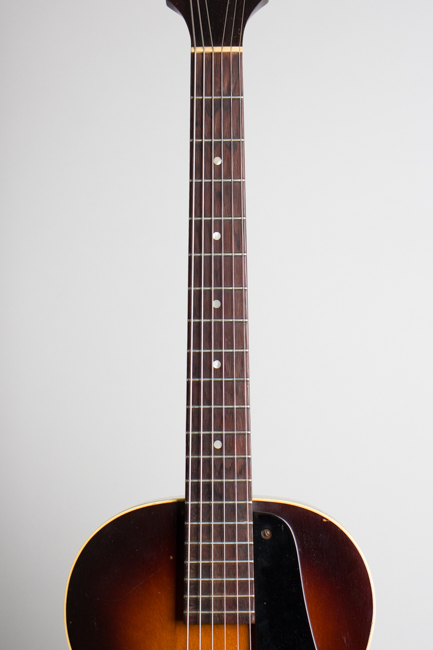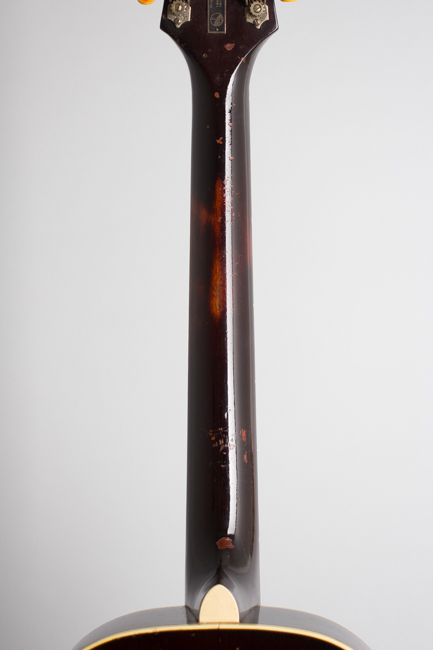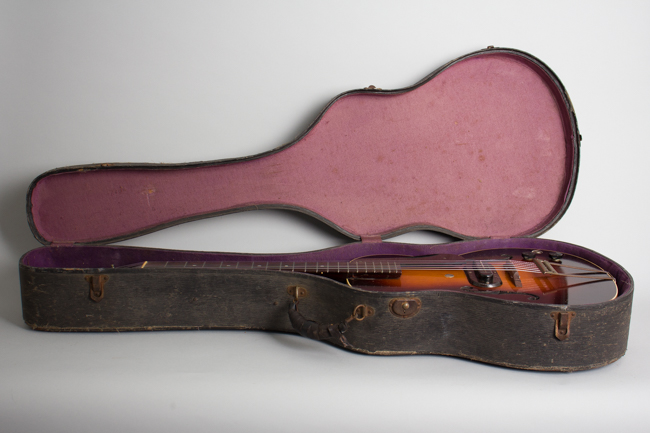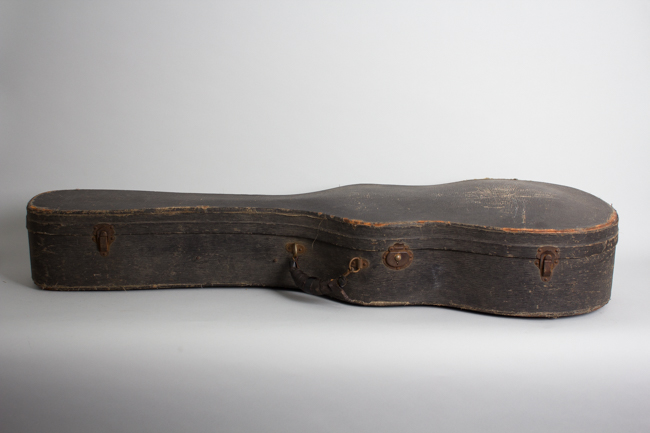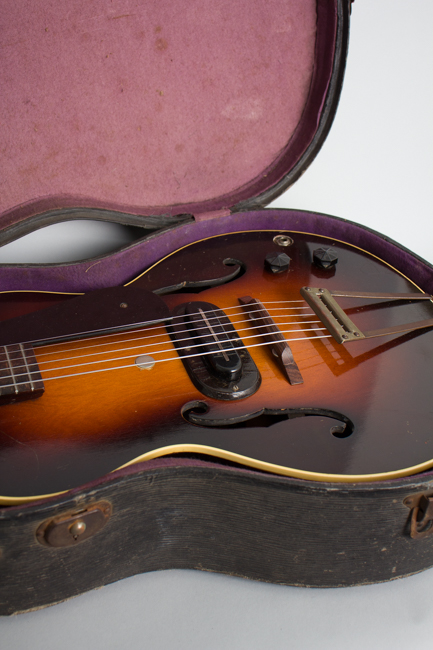Epiphone Electar Model C Hollow Body Electric Guitar (1937)
This item has been sold.
Item # 9759
Prices subject to change without notice.
Epiphone Electar Model C Model Hollow Body Electric Guitar (1937), made in New York City, sunburst top, dark back and sides finish, laminated maple body, mahogany neck with rosewood fingerboard, original black hard shell case.
This Epiphone Electar Spanish Model C is one of the world's first generation of commercial electric guitars, introduced in 1937 as the direct successor to the Model M, Epiphone's initial electric Spanish model. The major difference is the model C replaced the earlier Rickenbacker-style horseshoe magnet pickup with the first version of Epiphone's round-coil internal magnet unit. This earliest pickup lacks the adjustable poles Epiphone's Herb Sunshine developed soon after, but uses the same basic form. This guitar has tone and volume controls with octagonal radio knobs and a cool slightly recessed jack on the top
The Model C is an early example of a plywood through-designed electric archtop, not a converted acoustic shell and was purposely built heavily to reduce feedback. The top is flat, thick and very stoutly braced, with a large crossbar visible through the soundholes. The body is single bound back and front, in an overall brown finish with sunburst on top. It trimmed with a smaller black Bakelite pickguard. Access to the electronics is through a large plate on the back of the instrument. The pickup assembly is mounted to the body in a large oval ring with four securing screws.
The neck is quite slim for a 1930's instrument with a soft V profile. The unbound rosewood fingerboard has plain dot inlay. This example has a small Epiphone logo along with the larger "Electar" on the metal headstock plate. The tuners are individual plastic-button Grover Sta-tites; the serial number is impressed along the headstock top edge. The back of the headstock bears the "Licensed from Meissner Electronics" plate that marks many early electric instruments. Some makers caved in to Meissner's legal blackmail; Gibson and Rickenbacker fought back and won!
This is an interesting guitar historically and a cool instrument, if much less elegant than Gbson's competing ES-150. The price was an $100 with the amplifier in 1938, a full $50 less than the Gibson. With its flat top and heavily blocked construction it is in many ways more modern in concept, if a bit more mongrel-looking in appearance. The pickup has a lower output but sharper tone than the equivalent 1930's Gibson electrics, with a lot of twang and a bright singing quality. While this was not as appealing to jazz players in the 1930s it sounds pretty cool today, and the instrument has a cool eccentric, slightly archaic almost steampunk feel.
Overall length is 39 in. (99.1 cm.), 13 3/8 in. (34 cm.) wide at lower bout, and 3 3/8 in. (8.6 cm.) in depth, measured at side of rim. Scale length is 25 1/2 in. (648 mm.). Width of nut is 1 5/8 in. (41 mm.).
This ancient Electar remains largely original, intact and playable. There is not too much wear overall; the body finish shows dings, dents and scuffs but no major loss to the all-original finish. The back of the neck has some rub wear and some feelable dings and dents but nothing too serious. Hardly any binding shrinkage is evident, an better situation than found on many period New York-made guitars.
The somewhat archaic electronics appear original except for a couple of spliced wire sections. The neck was reset some time ago causing a small split on the bass side of the heel that is solidly sealed but visible. The guitar may have been refretted long ago; the wire shows a decent amount of wear in the lower positions but remains playable. The tailpiece broke off at the hinge in the distant past and someone added a different arm/crossbar assembly to the original base that has a distinctly industrial look to it; not authentic but kind of cool looking with a lot of age to it. The adjustable rosewood bridge is a 1960s Harmony piece, and the back coverplate is a reproduction.
While probably not everyone's choice as a gigging guitar this is a cool and rare period piece, a playable example of one of the earliest electric guitars to reach commercial production. While the original New York Epiphone company is better remembered for their exceptional acoustic archtops, they were very innovative with their electric line as well. This model C retains the original arched HSC, more-or-less functional with some wear and repair evident. Overall Very Good + Condition.
This Epiphone Electar Spanish Model C is one of the world's first generation of commercial electric guitars, introduced in 1937 as the direct successor to the Model M, Epiphone's initial electric Spanish model. The major difference is the model C replaced the earlier Rickenbacker-style horseshoe magnet pickup with the first version of Epiphone's round-coil internal magnet unit. This earliest pickup lacks the adjustable poles Epiphone's Herb Sunshine developed soon after, but uses the same basic form. This guitar has tone and volume controls with octagonal radio knobs and a cool slightly recessed jack on the top
The Model C is an early example of a plywood through-designed electric archtop, not a converted acoustic shell and was purposely built heavily to reduce feedback. The top is flat, thick and very stoutly braced, with a large crossbar visible through the soundholes. The body is single bound back and front, in an overall brown finish with sunburst on top. It trimmed with a smaller black Bakelite pickguard. Access to the electronics is through a large plate on the back of the instrument. The pickup assembly is mounted to the body in a large oval ring with four securing screws.
The neck is quite slim for a 1930's instrument with a soft V profile. The unbound rosewood fingerboard has plain dot inlay. This example has a small Epiphone logo along with the larger "Electar" on the metal headstock plate. The tuners are individual plastic-button Grover Sta-tites; the serial number is impressed along the headstock top edge. The back of the headstock bears the "Licensed from Meissner Electronics" plate that marks many early electric instruments. Some makers caved in to Meissner's legal blackmail; Gibson and Rickenbacker fought back and won!
This is an interesting guitar historically and a cool instrument, if much less elegant than Gbson's competing ES-150. The price was an $100 with the amplifier in 1938, a full $50 less than the Gibson. With its flat top and heavily blocked construction it is in many ways more modern in concept, if a bit more mongrel-looking in appearance. The pickup has a lower output but sharper tone than the equivalent 1930's Gibson electrics, with a lot of twang and a bright singing quality. While this was not as appealing to jazz players in the 1930s it sounds pretty cool today, and the instrument has a cool eccentric, slightly archaic almost steampunk feel.
Overall length is 39 in. (99.1 cm.), 13 3/8 in. (34 cm.) wide at lower bout, and 3 3/8 in. (8.6 cm.) in depth, measured at side of rim. Scale length is 25 1/2 in. (648 mm.). Width of nut is 1 5/8 in. (41 mm.).
This ancient Electar remains largely original, intact and playable. There is not too much wear overall; the body finish shows dings, dents and scuffs but no major loss to the all-original finish. The back of the neck has some rub wear and some feelable dings and dents but nothing too serious. Hardly any binding shrinkage is evident, an better situation than found on many period New York-made guitars.
The somewhat archaic electronics appear original except for a couple of spliced wire sections. The neck was reset some time ago causing a small split on the bass side of the heel that is solidly sealed but visible. The guitar may have been refretted long ago; the wire shows a decent amount of wear in the lower positions but remains playable. The tailpiece broke off at the hinge in the distant past and someone added a different arm/crossbar assembly to the original base that has a distinctly industrial look to it; not authentic but kind of cool looking with a lot of age to it. The adjustable rosewood bridge is a 1960s Harmony piece, and the back coverplate is a reproduction.
While probably not everyone's choice as a gigging guitar this is a cool and rare period piece, a playable example of one of the earliest electric guitars to reach commercial production. While the original New York Epiphone company is better remembered for their exceptional acoustic archtops, they were very innovative with their electric line as well. This model C retains the original arched HSC, more-or-less functional with some wear and repair evident. Overall Very Good + Condition.
